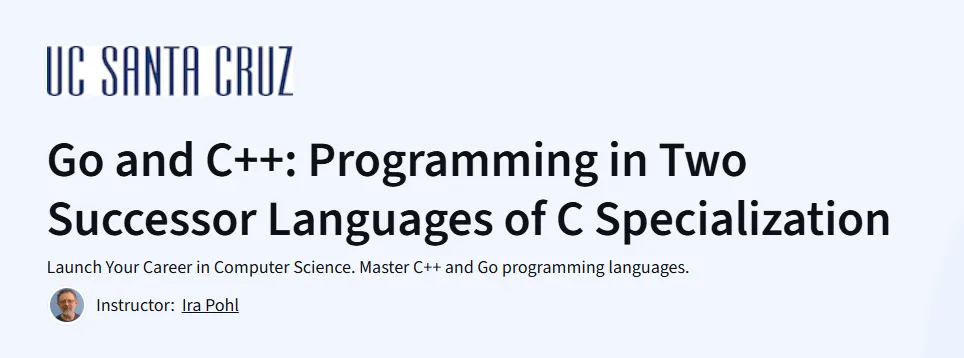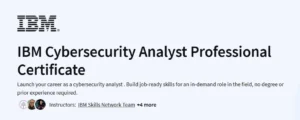What will you learn in Go and C++: Programming in Two Successor Languages of C Specialization Course
Write, compile, debug, and run programs in C, Go, and C++ across diverse development environments.
Apply core programming constructs: arrays, pointers, functions, storage classes, and control flow in C and Go.
Utilize Go’s modern features—slices, structs, interfaces, concurrency primitives (channels, goroutines), and testing frameworks.
Convert C code to C++, leverage STL containers, templates, and object-oriented design for efficient algorithms.
Program Overview
Course 1: C for Everyone: Programming Fundamentals
⏳ 15 hours
Topics: Basic syntax, compilation, arrays & pointers, functions, storage classes, logic operators, lexical elements, and data types.
Hands-on: Write simple C programs; compile, debug, and execute code using command-line tools.
Course 2: C for Everyone: Structured Programming
⏳ 9 hours
Topics: Command-line arguments, structured C constructs, debugging techniques, and IDE usage.
Hands-on: Develop modular C programs with command-line parameters and apply debugging workflows.
Course 3: GO Programming for Everyone: Part 1
⏳ 17 hours
Topics: Go fundamentals—data types, arrays, slices, pointers, functions, control flow, and recursion.
Hands-on: Build Go programs to process data structures, manage memory, and implement iterative/recursive logic.
Course 4: GO Programming for Everyone: Part 2
⏳ 16 hours
Topics: Advanced Go—type declarations, structs, methods, interfaces, Monte Carlo simulations, channels, workers, synchronization (mutex, waitgroup), and testing.
Hands-on: Create concurrent Go applications, implement inter-goroutine communication, and write integration tests.
Course 5: C++ For C Programmers, Part A
⏳ 14 hours
Topics: Transition from C to C++: container classes, object-oriented principles, and Dijkstra’s algorithm for shortest paths.
Hands-on: Convert procedural C codebases to C++ classes; implement and analyze graph algorithms.
Course 6: C++ For C Programmers, Part B
⏳ 14 hours
Topics: STL usage, inheritance, templates, and game-playing algorithms (Min-Max, Alpha-Beta).
Hands-on: Utilize STL containers and algorithms; develop AI game strategies and compare their performance.
Get certificate
Job Outlook
Roles: Systems Programmer, Backend Developer, Software Engineer, DevOps Engineer, and Algorithm Developer.
Demand: Organizations in systems software, cloud infrastructure, game development, and AI research seek proficiency in C, Go, and C++.
Salary: Entry to mid-level engineers earn $80K–$110K, rising to $120K+ for roles requiring performance-critical or concurrent programming expertise.
Growth: Mastery of low-level programming, concurrency, and modern C++ patterns accelerates advancement into senior engineering and architecture positions.
Specification: Go and C++: Programming in Two Successor Languages of C Specialization
|
FAQs
- Not designed for complete beginners.
- Basic knowledge of C or general programming logic is recommended.
- Familiarity with compilers and IDEs is helpful.
- Problem-solving and algorithmic thinking are expected.
- Best suited for students with structured programming foundations.
- Go is ideal for concurrent apps and cloud services.
- C++ is crucial for performance-heavy systems and algorithms.
- Teaches how to transition from C to C++ and Go.
- Allows direct comparison of strengths and limitations.
- Offers practical skills for both modern and legacy projects.
- Backend Developer in cloud-focused companies.
- Systems Engineer or DevOps roles in infrastructure.
- Game development and simulation engines.
- Algorithm development in AI and finance.
- Strong pathway into software architecture positions.
- Covers STL, templates, and object-oriented principles.
- Includes core algorithms such as Dijkstra and Min-Max.
- Builds strong C++ foundations for further study.
- Does not teach advanced C++20/23 concepts.
- Serves as a stepping stone to more advanced courses.
- Go projects focus on concurrency and inter-process communication.
- C++ projects apply graph algorithms and game logic.
- Each module has problem-solving exercises tied to real scenarios.
- Simulates workplace-style programming challenges.
- Provides directly applicable skills for professional coding.





